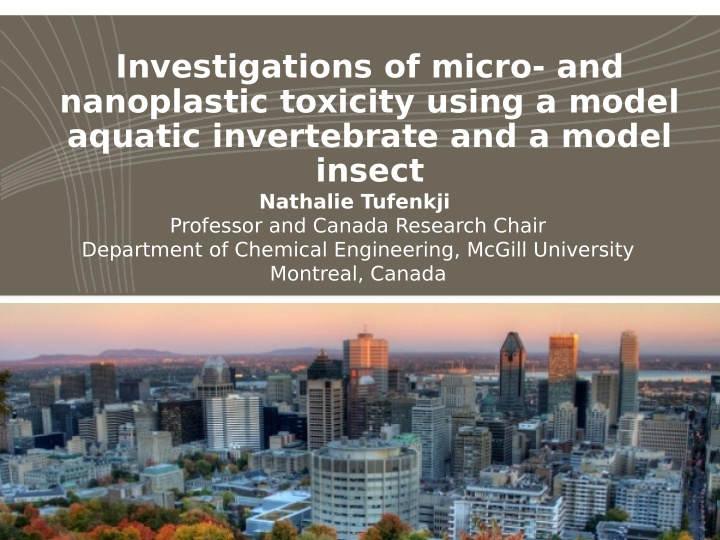



Investigations of micro- and nanoplastic toxicity using a model aquatic invertebrate and a model insect Nathalie Tufenkji Professor and Canada Research Chair Department of Chemical Engineering, McGill University Montreal, Canada
Microplastic and Nanoplastic Pollution on Land Sources of Micro- and Nanoplastics Consumer Products Plastics enter soils via direct application on cropland, wastewater Landfjll biosolids, release from s landfjlls, etc… Poor Waste Management Biosolids Application Plastic litter breaks Plastic down into Mulch secondary microplastics and nanoplastics. T ufenkji and Emelko Encyclopedia Env Health 2010
Need for Studies on Freshwater and T errestrial Animals Animal models in this study: Daphnia magna (water fmea) Transparent, fast reproduction, cheap and easy to work with. Drosophila melanogaster (fruit fmy) Genetic, proteomic, and physiological similarities Few studies of to humans micro/nanoplastic uptake in terrestrial or freshwater organisms uyen et al, Accounts of Chemical Research , 2019.
Study 1. Chronic Efgects of Leachate of Weathered Plastic 20 days fjltration 100% 80 g plastic debris/L
Study 1. Chronic Efgects of Leachate of Weathered Plastic 20 days 100% 50% 10% 0% X 3 fjltration 100% 48 h acute test 80 g plastic debris/L
Study 1. Chronic Efgects of Leachate of Weathered Plastic 20 days 100% 50% 10% 0% X 3 fjltration 100% 48 h acute test 100% 80 g plastic debris/L X 10 0% 10 day chronic test
Secondary Microplastics and Nanoplastics in Leachate There are 500 times more nanoplastics than microplastics. Xu et al, Environmental Science: Nano , under review.
Plastic Leachate Contains Low Metals but Complex Organics Several metals are A complex mixture of detected at organic compounds, concentrations < LC 50 in including bisphenol A Daphnia . is released from the plastics. Xu et al, Environmental Science: Nano , under review.
Leachate Afgects Growth, Reproduction, and Physiology No No change change in in heart swimming beat distance Increased Decreased fecundity appendag e beat No Increased signifjcant body size mortality Observed sublethal efgects due to mixture of microplastics, nanoplastics and leached chemicals. Xu et al, Environmental Science: Nano , under revi
Study 2. Acute Efgects of Food Packaging Debris 100% 372 g plastic teabags plastic packaging/L ernandez et al, Environ. Sci. T echnol. , under review.
Food Packaging Releases High Levels of MPs and NPs When drinking 1 cup of tea, a person can mean mean ingest: diameter diameter ~ 100 nm ~ 25 µm 2 million micro-sized plastics ~ 2×10 6 ~ 15×10 9 particles/teab particles/teab 15 billion sub-micron ag ag plastics ernandez et al, Environ. Sci. T echnol. , under review.
Study 2. Acute Efgects of Food Packaging Debris 100% plastic teabags 10 cm climbing assay ernandez et al, Environ. Sci. T echnol. , under review.
Food Packaging Debris Afgects Fly Survival and Behavior PET teabag leachate Percent Survival Time (hours) Female fmies are more susceptible than male fmies.
Food Packaging Debris Afgects Fly Survival and Behavior PET teabag leachate Flies climbing above 10 cm (%) SEM of fruit fmy eyes SEM of fruit fmy legs
Concluding Remarks • Bulk plastics can degrade into millions of microparticles and billions of nanoparticles • Weathered plastic leachate can exhibit low toxicity but can impact growth, reproduction and feeding behavior. • Plastic use in food packagings can lead to undesirable contamination of foods with high levels of micro- and nanoplastics 15
Acknowledgements Students and Postdocs Dr. Genbo Xu Dr. Vimal Maisuria Rachel Cheong Laura Hernandez Agil Azimzada Collaborators Prof. Hans Larsson Prof. Stephane Bayen We have a funded Funding Agencies postdoc position in Canada Research Chairs Program ecotoxicology . Please Canada Foundation for Innovation NSERC contact me! McGill University Faculty of Engineering visit us: www.biocolloid.mcgill.c
Extra Slides 17
Microplastics and Nanoplastics on Daphnia Scanning electron microscopy is used to image plastic particles on the carapace and antenna of Daphnia . et al, Environmental Science: Nano , under review.
Secondary Microplastics and Nanoplastics in Leachate 21.2×10 6 particles/mL 1 Fraction 0 2000 4000 nm 4000 nm Ferret diameter (nm) 2,500× Particle diameter (nm) 10.8×10 9 particles/mL 1 Fraction 1000 nm 1000 nm 0 190 100,000× Ferret diameter (nm) Particle diameter (nm) Xu et al, Environmental Science: Nano , under review.
Chemical Contaminants in Leachate Proposed formula Tentative identity ESI+ C 9 H 19 NO 4 Dexpanthenol C 8 H 19 NO 2 N-Butyldiethanolamine C 17 H 26 O 3 4-Nonylphenoxyacetic acid C 20 H 34 O 4 1,4-Bis{2-[(2-methyl-2-propanyl)peroxy]-2-propanyl}benzene C 22 H 30 O 4 Bis(4-methylcyclohexyl) phthalate (4-Methalate) C 22 H 30 O 4 Bis(4-methylcyclohexyl) phthalate (4-Methalate) C 20 H 30 O 2 Abietic acid ESI- C 7 H 8 O 3 S Toluene sulfonic acid C 13 H 22 O 4 Dibutyl itaconate C 7 H 7 NO 3 5-Aminosalicylic acid C 13 H 16 O 4 Monopentyl phthalate C 20 H 22 O 3 Avobenzone C 12 H 16 O 3 2,2-Diethoxyacetophenone C 15 H 16 O 2 Bisphenol A (BPA)* C 20 H 34 O 4 1,4-Bis{2-[(2-methyl-2-propanyl)peroxy]-2-propanyl}benzene C 20 H 30 O 2 Abietic acid Xu et al, Environmental Science: Nano , under review.
Recommend
More recommend